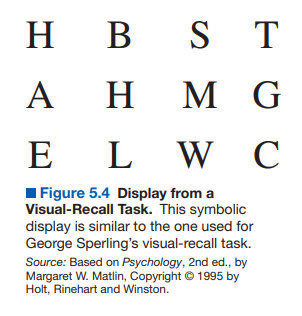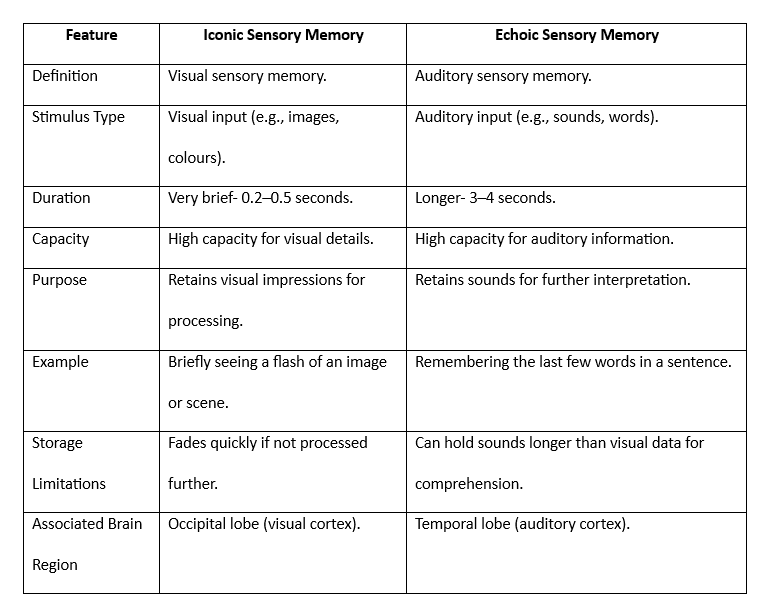Introduction
Sensory memory is the first stage of memory processing, where sensory information from the environment is briefly stored before either being transferred to short-term memory or discarded. It consists of different types of registers based on sensory modalities:
- Iconic Memory (Visual sensory store)
- Echoic Memory (Auditory sensory store)
- Haptic Memory (Tactile sensory store)
Sensory memory serves as a temporary buffer, capturing incoming stimuli in their raw form before they undergo higher-level cognitive processing (Atkinson & Shiffrin, 1968). This type of memory has a limited duration and is subject to rapid decay.
Iconic Memory (Visual Sensory Store)
Iconic memory is the visual component of sensory memory, holding visual images (icons) for a very brief duration. This allows the brain to process visual stimuli even after they have disappeared from view. Key characteristics include-
- High capacity- Iconic memory can store a large amount of visual information.
- Short duration- Information fades within approximately 150–300 milliseconds (Sperling, 1960).
- Visual persistence- A fleeting image remains in memory briefly after the actual stimulus is removed, contributing to motion perception and continuity.
Sperling’s Experiment on Iconic Memory (1960)
One of the most influential studies on iconic memory was conducted by George Sperling in 1960. He devised two experimental procedures to measure the capacity and duration of iconic storage-

Display from Visual Recall Task
Whole-Report Procedure
- Participants were shown a 3×4 grid of letters for a brief duration (50 milliseconds).
- After the display disappeared, they were asked to recall as many letters as possible.
- Results showed that participants could only recall about 4–5 letters, even though they reported having seen more.
Partial-Report Procedure
- Sperling modified the experiment by introducing a tone immediately after the display disappeared.
- A high-pitched tone signaled recall of the top row, a medium-pitched tone signaled the middle row, and a low-pitched tone signaled the bottom row.
- Participants could recall about 9 out of 12 symbols when cued immediately.
- However, when the tone was delayed for more than 1 second, recall dropped significantly, showing that iconic memory fades rapidly.
Findings and Implications

Results from Sperling Study
- The partial-report method demonstrated that iconic memory holds more information than whole-report results suggested.
- The information stored in iconic memory decays within one second.
- Iconic memory is crucial for visual continuity and pattern recognition.
Backward Visual Masking

Averbach & Coriell (1961)
- Averbach & Coriell (1961) extended Sperling’s work, showing that iconic memory can be erased by subsequent visual stimuli.
- If another image is shown within 100 milliseconds of the first, it can overwrite the original memory, a phenomenon known as backward visual masking.
Read More- Memory Models
Echoic Memory (Auditory Sensory Store)
Echoic memory is the auditory equivalent of iconic memory, briefly storing sound-based information before it is processed further. Key characteristics include-
- Larger capacity than iconic memory.
- Longer duration- Information persists for 2–4 seconds.
- Essential for speech comprehension- Helps process spoken language and detect patterns in sound.
Sperling’s Experiment on Echoic Memory
Following his iconic memory experiments, Sperling (1963) conducted a similar study to investigate auditory sensory memory.
Procedure
- Participants were presented with three sets of spoken letters from different spatial locations (left ear, right ear, and both ears simultaneously).
- After hearing the letters, participants were given a visual cue indicating which set they needed to recall.
Findings
- When the cue was given immediately after the sound ended, participants recalled more items than when the cue was delayed.
- Echoic memory lasts longer than iconic memory (about 2–4 seconds).
- Delayed cues led to significant decay, confirming that echoic memory fades over time but persists longer than visual sensory memory.
Implications
- Echoic memory helps us perceive speech as continuous rather than fragmented.
- It allows us to recognize and process auditory patterns even after the original sound has ceased.
Comparison of Iconic and Echoic Memory

Iconic and Echonic Memory
Conclusion
Sensory memory plays a crucial role in cognitive processing by briefly holding environmental stimuli. Iconic memory allows for visual persistence and rapid recognition, while echoic memory ensures auditory continuity and speech processing. Sperling’s experiments provided foundational evidence for these transient memory stores, shaping modern theories of memory and perception.
References
Atkinson, R. C., & Shiffrin, R. M. (1968). Human memory: A proposed system and its control processes. The Psychology of Learning and Motivation: Advances in Research and Theory, 2, 89–195.
Averbach, E., & Coriell, A. S. (1961). Short-term memory in vision. The Bell System Technical Journal, 40(1), 309–328.
Sperling, G. (1960). The information available in brief visual presentations. Psychological Monographs: General and Applied, 74(11), 1–29.
Sperling, G. (1963). A model for visual memory tasks. Human Factors, 5(1), 19–31.
Sternberg, R. J., & Sternberg, K. (2016). Cognitive psychology (7th ed.). Cengage Learning.
Subscribe to Careershodh
Get the latest updates and insights.
Join 18,524 other subscribers!
Niwlikar, B. A. (2025, January 8). 2 Important Types of Sensory Memory. Careershodh. https://www.careershodh.com/2-important-types-of-sensory-memory/
